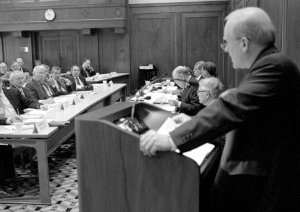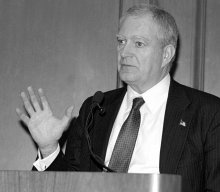 |
|
URA Council of Presidents Hears from Science Policymakers by Judy Jackson
“It seems that the surest way to higher office in this town,” Bernthal jokingly told the assembled representatives of URA member universities, “is to serve on a URA governing board.”
As evidence, Bernthal cited President George W. Bush’s recent nomination of URA Trustee Ray Orbach to be director of the Department of Energy’s Office of Science; the appointment of Fermilab Overseer Arden Bement as Director of the National Institute of Standards and Technology; and the appointment of former long-time URA Trustees Chairman Jack Marburger as chief science advisor to the President and Director of the Office of Science and Technology Policy. As a steppingstone to positions of influence in national science policy, it’s not a bad record.
One of URA’s illustrious old grads, OSTP’s Marburger, returned to address the annual gathering he had so often attended in the past. Besides serving as the URA “stockholders meeting,” the annual Council meeting, traditionally held in the Lecture Room of the National Academy of Sciences, has become a Washington science policy forum with addresses from legislators and Administration officials. Besides Marburger, speakers at this year’s meeting included Rep. Rush Holt (D-NJ), one of the two physicists in Congress; National Science Foundation Director Rita Colwell; and DOE Under Secretary Robert Card.
“I well remember sitting in this room year after year,” Marburger told the university representatives. “It was here, in 1991, that the late Representative George Brown, former chair of the House Science Committee, made clear that with the end of the Cold War the world was reassessing the relationship between science and society. There had been an implicit link between support for the physical sciences and national security. Brown foresaw that especially high-energy physics would come under scrutiny because it was seen as no longer necessary for national security, and he was concerned about the mood in Congress to expect science funding to drop.”
Marburger noted that the end of the Cold War also coincided with a sharp rise in the capability for research, citing increases in computing power and visualization technology that opened up new vistas in science.
“It was a time of emerging possibilities on the one hand and scrutiny and skepticism on the other,” Marburger said. “It made things a little complicated for the national laboratories.”
In most cases, Marburger told the audience, he believes that the DOE laboratories have done their best to adapt to user demands and to clarify their missions in response to post-Cold War changes.
“These labs are catalysts and focal points for user communities,” Marburger said. “The investments that the federal government makes in the national labs generate the capability for national security, for addressing energy and environmental issues, and also provide access to the tools to conduct science. I believe that society is ready to support science at these labs, but the whole picture is so complicated that it will take more than we have done in the past to explain why they are an essential part of the nation’s science apparatus.”
Marburger echoed a question on the minds of many physicists, namely how to communicate the insight that much of the science that ultimately produces high-profile (and well-funded) biomedical advances comes initially from physics. While basic science is a DOE mission, he said, other DOE missions compete for funding.
“There are many obscuring features in the way of a clear picture of science at DOE,” Marburger said. “There is competition within DOE to the disadvantage of the science mission.”
“Discovery is important to this administration,” he said. “There is an emphasis on long-range, high-risk research. It is the administration’s great desire to see industry take up applied research. So there is a natural inclination to support basic science. The president believes that the opportunities for society from increased investment in medical research are vast. Now the trick is to get a balance, to make sure that physical science gets funded to maintain the pace of discovery. Here in Washington, I am trying to help. I hope you will continue to call on me.”
Representative Rush Holt, former assistant director of Princeton Plasma Physics Laboratory, is another Washington champion of basic science. His opening statement that he had reviewed the High Energy Physics Advisory Panel’s Plan for the Long-Term Future of U.S. High-Energy Physics, released two days earlier, elicited pleased exclamations from the audience.
Holt said that reading the report reminded him of what “good citizens” the scientists of the high-energy physics community are.
“I was very pleased to have an opportunity to look at the report’s recommendations,” he said, “and I generally endorse them. High-energy physics has a great tradition. Eleven of the twelve fundamental constituents of matter were discovered in the United States. High-energy physics is one of the hallmarks of a civilized society, and we must strive to maintain leadership at all levels.”
The New Jersey Congressman suggested that plans for the future of high-energy physics would benefit from more emphasis on collaboration with developing nations. Besides an increased understanding of the physical world, he said, international projects like the new linear collider proposed by the HEPAP report bring direct benefits in international cooperation.
“I would extend the HEPAP recommendations,” Holt said. “There is not enough attention paid to reaching out to the developing world, not just to Japan and CERN. Just as education of our children should be part of the structure of scientific projects, so should outreach to the developing world.”
Under Secretary Card also commented on the HEPAP recommendations to build a linear collider.
“A linear collider seems like an interesting project,” Card said. “But it will depend on making the case for its value to the nation. HEPAP has done a good job of convincing the physics community, but there is still a long way to go to convince others.”
Responding to a question from the audience, he referred to remarks made last fall by Energy Secretary Spencer Abraham on DOE’s mission and priorities. Card explained that the remarks had been “widely misinterpreted” to mean that the Secretary saw no place for basic science, such as high-energy physics, in the DOE mission. On the contrary, he said, DOE remains committed to its role in building and operating large scientific facilities.
“We don’t want to compete for missions with other agencies,” Card said. “We build and operate big machines. We do a good job. We have a core competence to protect, and when we have a problem with a big scientific project, it cuts at the core competence of DOE.”
For her part, the National Science Foundation’s Rita Colwell embraced the concept of science as patriotism. Firefighters and soldiers are patriots and heroes, Colwell said, but a re-examination of personal and national goals since the terrorist attack of September 11 has convinced her that scientists and engineers are patriots as well. Through their contributions to national security and to economic well-being and education, scientists have the opportunity for “global patriotism” by improving the lot of humankind.
In other business, the Council elected URA’s ninetieth member, the Illinois Institute of Technology; heard an appeal from President Bernthal for increased support for the DOE Office of Science, and elected new officers of the URA Board.
Based on their predecessors’ experiences, they may want to begin preparing for higher office.
Members of Universities Research Association, inc
Universities Research Association Inc.
|
 Universities Research Association President Fred Bernthal led off URA’s 37th annual Council of Presidents meeting in Washington, DC last month with some tongue-in-cheek advice for job seekers.
Universities Research Association President Fred Bernthal led off URA’s 37th annual Council of Presidents meeting in Washington, DC last month with some tongue-in-cheek advice for job seekers.
 Marburger assured the audience of the support of the Bush administration for basic science.
Marburger assured the audience of the support of the Bush administration for basic science.